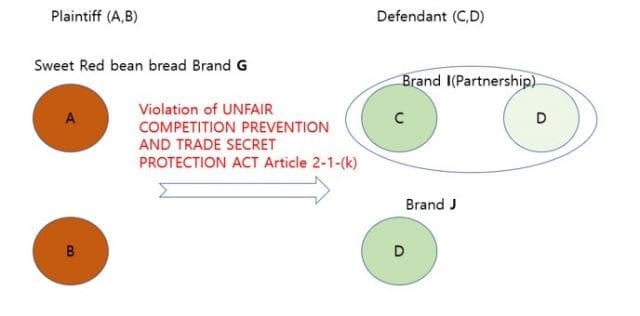Today, we will look at a case that is important in the anti-competition law. This is the first case in Korea to apply Article 2 (1) (k) of the Unfair Competition Prevention Act (darts-340-410-H-ko, darts-794-496-D-ko, darts-793-159-E-ko). Article 2-1 of the Unfair Competition Prevention Act lists acts that correspond to unfair competition practices, and among these, Article2(1) (k) defines “any other acts of infringing on other persons’ economic interests by using the outcomes, etc. achieved by them through substantial investment or efforts, for one’s own business without permission, in a manner contrary to fair commercial practices or competition order” as unfair competition practice. Current (2)(1)(K), which was originally enacted in Article 2(1)(j) was newly entered into the Unfair Competition Prevention Act on July 7, 2013, as part of the amendment.
The case we will look at today is the first case that applies this Act, which is an important indicator. Let’s look at the facts first.
Plaintiff A and B were operating ‘G Sweet Bean Bread’ at KORAIL Airport Railroad Station E and Subway station F. Defendant C worked as a plaintiff’s baker and then left office in 2013 and then operated “I Red Bean Bread” at Subway H Station with Defendant D from 2013.12.5 to 2014.5.21. After the partnership, Defendant D changed his business name to “J Red Bean Bread” and sold red bean bread made in the same way as before. The plaintiff filed a lawsuit for damages against the defendant, in violation of the (j) (currently (k)) of the Unfair Competition Prevention Act.

The trial court judged about 3 following points: ① whether the plaintiffs’ store is a result of substantial investments or efforts by the plaintiffs, ② whether the plaintiffs’ store formed a trade dress through the components, ③ whether the defendant’s operation of the store is an unauthorized use of the plaintiff’s performance.
First, about the ①issue, the court decided that the plaintiffs visited Japan several times, researched interiors, promotional materials, etc., and commissioned design firms to produce store designs. In sum, the court concluded that the plaintiffs’ store was recognized as a result of the substantial investment and efforts of the plaintiffs. (darts-340-410-H-ko).
Before explaining the ② issue, there is a good explanation about ‘trade dress’.
“Trade dress” means a complex intangible element used to represent a unique image of a product or service, such as color, size, or shape. The shape of the Coca-Cola bottle makes it easy to understand. Coca-Cola bottles, such as the shape of a woman’s waist and a wave pattern on the surface, have a unique shape that is different from other beverage bottles. The distinctive feature of Coca-Cola bottles, which distinguishes them from other beverage bottles, is the trade dress. So if you can look at the overall exterior design and think of a particular brand, the design is patentable, and the key to the ‘trade dress’ is that. “ (Source: Naver Dictionary(네이버 지식백과), 트레이드 드레스 [Trade Dress] (트렌드 지식사전, 2013. 8. 5., 김환표).”
In this case, the question was whether the plaintiffs’ stores could be recognized as a trade dress as a whole. In response, the court found that the plaintiff’s interior of the store was a combination of several factors, “acquiring uniqueness and discrimination”(darts-340-410-H-ko).
“Plaintiffs chose the colors and signage of the above colors to create a unique store atmosphere that is calm, clean and luxurious throughout. In addition, by incorporating the shapes such as the sign and signboard of the above shape into various promotional materials and packaging containers, consumers were informed that high-quality sweet-red-bean bread is the main product of Plaintiffs. An open store layout was opened to the customer to reveal the manufacturing process to the customer so that they could see the entire process from kneading to fermentation and baking in the oven. Through this, plaintiffs created the unique atmosphere of plaintiffs’ sales or plaintiffs’ stores as a whole, such as highlighting the image of fresh and healthy sweet-red-bean bread. In this way, the plaintiff’s business or plaintiff’s stores gained their uniqueness and differentiation compared to other stores.” (darts-340-410-H-ko)
(Photo Source: 한겨례신문, 단팥빵 전쟁에까지 뛰어든 ‘빵빵한’ 로펌들, 2016.10.23, 민은희 제공)

Plaintiff’s store Defendant’s store
On the issue ③, the court also accepted plaintiff’s claim that the operation of the defendant’s store was an unauthorized use of plaintiff’s performance.
“The defendants operated the defendants ‘stores by copying the elements of the plaintiffs’ stores and by adopting them as they were or by modifying only the letters of the business name or the signboard. The defendants thus made consumers feel that the defendants ‘stores and the plaintiffs’ stores were identical or very similar. Therefore, defendants’ operation of the defendant’s store as described above corresponds to the unauthorized use of the plaintiff’s achievements.” (darts-340-410-H-ko)
The defendants later appealed, but both the appeals and the Supreme Court came to the same conclusion. It should be noted that this ruling is one of the first precedents of the application of anti-competition law (k) and that ‘trade dress’ is protected by the anti-competition law. Trade dress is a new concept in Korea, and there is no legal provision to protect it directly. However, through the formation of such precedents and the Unfair Competition Prevention Act (K), the trade dress can be now indirectly protected. However, as ‘complex intangible elements that symbolize the brand'(which is a meaning of a ‘trade dress’) has a broad spectrum of interpretation, in order to win, it will be necessary to utilize a database of related cases and formulate a strategy accordingly.





